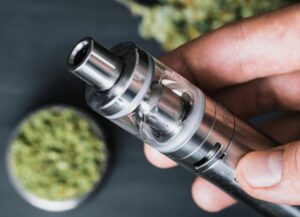"What should I know if I am trying to decide between them?"
Both of these devices are among the best-rated in the portable vaporizer market.
The main difference between the two devices is the method by which they heat. The Pax vaporizer uses conduction, while the FireFly uses convection.
Conduction is the heating of a substance that is in direct contact with the heat source. Convection is heating of a substance by the transfer of heat from air particles. The Pax vaporizer uses conduction, while the FireFly uses convection.
Both methods of heating have advantages and disadvantages for the purpose of vaporizers. For the purposes of this discussion, we will assume you are vaporizing shredded flowers.
It is typically faster to heat by conduction (although, while the Pax takes approximately 45s to heat up, the Firefly only takes 3s) and conduction vaporizers are easier to construct; therefore, conduction devices are usually cheaper. The medicine will have to be stirred between draws, because only the herb touching the conductive surface is vaporized. Conductive vaporizers have a greater likelihood of combusting the herbs, which is what we are trying to avoid (unhealthy bi-products of combustion).
Convective heating typically takes longer (again, not in the case of the FireFly). Convection vaporizers are more sophisticated and are usually more expensive. Convective vaporizers work better with shredded flower that is not packed into the bowl, so that the heated air can come into more contact (greater surface area) with the flower. The herbs do not need to be stirred to vaporize all of them. Convective vaporizers are less likely to cause combustion than conductive vaporizers and have more accurate temperature control.
One of the major considerations with vaporizers are the vapor "quality," or flavor. This is determined by the heating method (convection is less likely to carry a burnt flavor) as well as the vapor path. The Pax has a plastic path, while the FireFly uses borosilicate glass. Most reviews indicate that the vapor quality of the FireFly is superior to that of the Pax.
Other factors to consider are price (The FireFly2 is $329 while the Pax2 is $279); portability/discreetness, determined by size and weight (Firefly is bigger, 140g and 5" compared to 90g and 4" – The Pax is one of the most portable vaporizers on the market); and cleaning/maintenance (Most reviews suggest the FireFly is easier to clean and requires less frequent cleanings.); bowl size (The Pax bowl is more than twice as big as the FireFly); battery life (similar for both devices); and battery charge time (Pax may take up to twice as long as the FireFly, and the FireFly comes with a spare battery).
dredmunds
Thank you @DrEdmunds for your very thorough answer! I have a few more points to add:
Firefly can vaporize both loose-leaf herb and concentrates whereas Pax only works with loose-leaf material. The Firefly2 model comes with concentrate pads that you place directly in the bowl before adding your concentrate of choice.
The dynamic convection technology in the Firefly is completely unique and provides a special experience. With Firefly, your breath pulls the superheated air through the bowl, so your material only heats while you inhale, capturing more terpenes and active cannabinoids. This means you inhale every active ingredient as it is vaporized, creating a rich flavor and very clear experience of your chosen strain. Another added bonus is less waste – the bowl may be smaller than Pax’s but you will get more out of it.
RachelDugas
Hello there! I think one of the main points to be considered with both of these vaporizers is the way they transfer heat. The Pax is a combustion vaporizer, while the Firefly is a true convection vaporizer. As Doctor Edmunds very thoroughly explained, conduction is the transfer of thermal energy (heat) to a substance of choice through its directs contact to a solid heat source, while convection is that same transfer of heat through the contact with a liquid or gas which is moving in order to reach the substance that wants to be eventually heated.
You can think of it like this. Let’s say that Adam is dribbling his basketball around the court and he wants to pass it to his friend Bob, but he couldn’t do it directly himself. He has two options. The first option would be lining up five of his teammates so that they could pass each other the ball one by one until it reached Bob. The other option would be to pass the ball to one particular friend, Carlos, who would then dribble it through the court and then pass it to Bob.
There are pros and cons to both options. The first option has more middlemen, who in turn could do something unexpected to the ball; for example set it on fire. I don’t know about you, but nobody I know wants a fiery ball. This is also the case with combustion, since when you heat up a solid the distribution does not tend to be particularly even, so there is a higher probability of your burning part of your medication. Since in convection one raises the temperature of the gas evenly to a certain degree before it comes in contact with the substance, the probability of burning your herb is practically null.
However, getting those ‘five friends’ to do a low effort task will probably be easier and faster than it would be to convince Carlos to run all the way to Bob and pass the ball. Conduction tends to take a lot less time to happen than convection does (although this is not the case with the firefly) since there is no travel time and the amount of energy that it takes to heat up the solid (usually metal) is also less than the amount needed to heat of the gas.
As I hinted at before, Carlos might not be so easy to convince to take the ball all the way to Bob’s side of the court, so you might need to give him some of your extra cash in order for him to actually do it. This also tends to be the case with equipment that uses convection, since more complicated energy transfers lead to higher prices.
At the end of the day a lot of it comes down to personal preference, but in terms of evenness of heating and accurate temperature of vaporization, convection (and therefore the Firefly 2) usually takes the cake (or ball, if we’re still following that analogy). If you’re looking for a cheaper option which will still have a reasonably fast heat up time, but might potentially burn some of your herbal products, then the Pax will also do the trick. Both of them are very well reviewed vaporizers in the current market.
The real takeaways from this unnecessarily long answer are that science can be sort of cool, and you should never set your friend’s ball on fire. That’s just a dick move.
Be well!
~Mike
mikeyh
Well, I don’t think anyone addressed the biggest issue. I am a frequent user, and when it comes to sitting down, cleaning my Pax, packing a Pax bowl, turning the unit on, waiting 1 minute, then vaping for 2-3 minutes then turn the unit off, continue to draw on the residual heat so i don’t get gunk build up for about 30 seconds.
5-10 minutes of usage time
That’s the basic time frame for any daily user with a PAX 2, Dont get my started on the PAX 1
The Fire Fly 2 on the other hand, is a smaller chamber, as well as heat on demand, want to sneak outside and take a hit in under 20 seconds, Be my guest, want to grab a quick couple hits while your in your lobby of a game your about to play, go blaze for a minute or so.
10-45 seconds usage time
This is not possible with the PAX 2. Although it is a very nice unit with a great warranty, I now own both units, And FireFly 2 is my go to because I waste ALOT LESS product with the FireFly 2.
dawson





